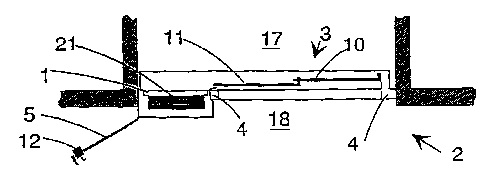Some of the information on this Web page has been provided by external sources. The Government of Canada is not responsible for the accuracy, reliability or currency of the information supplied by external sources. Users wishing to rely upon this information should consult directly with the source of the information. Content provided by external sources is not subject to official languages, privacy and accessibility requirements.
Any discrepancies in the text and image of the Claims and Abstract are due to differing posting times. Text of the Claims and Abstract are posted:
| (12) Patent: | (11) CA 2148567 |
|---|---|
| (54) English Title: | ARRANGEMENT IN AN OPENING IN THE WALL OF AN ELEVATOR SHAFT AND INSTRUMENT PANEL |
| (54) French Title: | LOGEMENT DU TABLEAU DE BORD DANS UNE OUVERTURE DE LA PAROI D'UN PUITS D'ASCENSEUR |
| Status: | Expired and beyond the Period of Reversal |
| (51) International Patent Classification (IPC): |
|
|---|---|
| (72) Inventors : |
|
| (73) Owners : |
|
| (71) Applicants : |
|
| (74) Agent: | G. RONALD BELL & ASSOCIATES |
| (74) Associate agent: | |
| (45) Issued: | 2002-07-16 |
| (22) Filed Date: | 1995-05-03 |
| (41) Open to Public Inspection: | 1995-11-05 |
| Examination requested: | 1998-08-12 |
| Availability of licence: | N/A |
| Dedicated to the Public: | N/A |
| (25) Language of filing: | English |
| Patent Cooperation Treaty (PCT): | No |
|---|
| (30) Application Priority Data: | ||||||
|---|---|---|---|---|---|---|
|
The instrument panel of an elevator is placed in the same opening in the wall of the elevator shaft as the landing door of the elevator. The instrument panel contains elevator control equipment and the electric drive controlling the hoisting motor of the elevator. The instrument panel of the elevator is connected to the jamb structure of the landing door.
Le tableau de bord d'un ascenseur est placé dans la même ouverture de la paroi du puits d'ascenseur que la porte palière de l'ascenseur. Le tableau de bord contient un équipement de commande d'ascenseur et l'entraînement électrique commandant le moteur de levage de l'ascenseur. Le tableau de bord de l'ascenseur est relié à la structure de montant de la porte palière.
Note: Claims are shown in the official language in which they were submitted.
Note: Descriptions are shown in the official language in which they were submitted.

2024-08-01:As part of the Next Generation Patents (NGP) transition, the Canadian Patents Database (CPD) now contains a more detailed Event History, which replicates the Event Log of our new back-office solution.
Please note that "Inactive:" events refers to events no longer in use in our new back-office solution.
For a clearer understanding of the status of the application/patent presented on this page, the site Disclaimer , as well as the definitions for Patent , Event History , Maintenance Fee and Payment History should be consulted.
| Description | Date |
|---|---|
| Time Limit for Reversal Expired | 2014-05-05 |
| Letter Sent | 2013-05-03 |
| Inactive: IPC from MCD | 2006-03-11 |
| Inactive: IPC from MCD | 2006-03-11 |
| Grant by Issuance | 2002-07-16 |
| Inactive: Cover page published | 2002-07-15 |
| Pre-grant | 2002-04-05 |
| Inactive: Final fee received | 2002-04-05 |
| Amendment After Allowance Requirements Determined Compliant | 2001-11-21 |
| Letter Sent | 2001-11-21 |
| Amendment After Allowance (AAA) Received | 2001-11-07 |
| Notice of Allowance is Issued | 2001-10-16 |
| Notice of Allowance is Issued | 2001-10-16 |
| Letter Sent | 2001-10-16 |
| Inactive: Approved for allowance (AFA) | 2001-09-28 |
| Amendment Received - Voluntary Amendment | 2000-11-07 |
| Inactive: S.30(2) Rules - Examiner requisition | 2000-08-21 |
| Amendment Received - Voluntary Amendment | 1999-08-12 |
| Inactive: Application prosecuted on TS as of Log entry date | 1998-09-11 |
| Inactive: RFE acknowledged - Prior art enquiry | 1998-09-11 |
| Inactive: Status info is complete as of Log entry date | 1998-09-11 |
| Request for Examination Requirements Determined Compliant | 1998-08-12 |
| All Requirements for Examination Determined Compliant | 1998-08-12 |
| Deemed Abandoned - Failure to Respond to Maintenance Fee Notice | 1997-05-05 |
| Inactive: Adhoc Request Documented | 1997-05-05 |
| Application Published (Open to Public Inspection) | 1995-11-05 |
| Abandonment Date | Reason | Reinstatement Date |
|---|---|---|
| 1997-05-05 |
The last payment was received on 2002-04-25
Note : If the full payment has not been received on or before the date indicated, a further fee may be required which may be one of the following
Please refer to the CIPO Patent Fees web page to see all current fee amounts.
Note: Records showing the ownership history in alphabetical order.
| Current Owners on Record |
|---|
| KONE OY |
| Past Owners on Record |
|---|
| ESKO AULANKO |
| HARRI HAKALA |
| JORMA MUSTALAHTI |